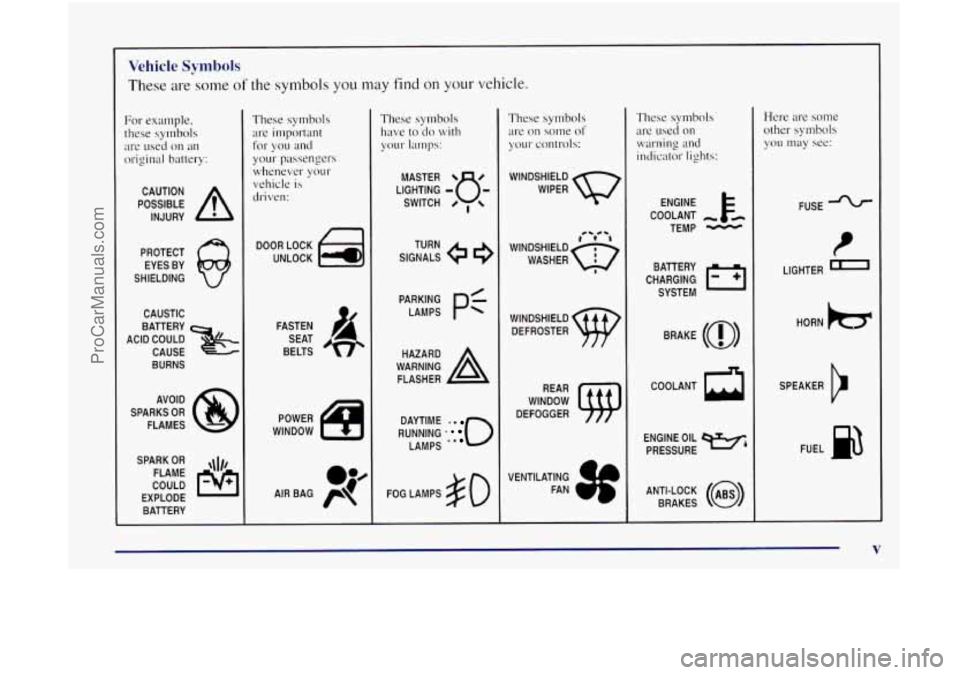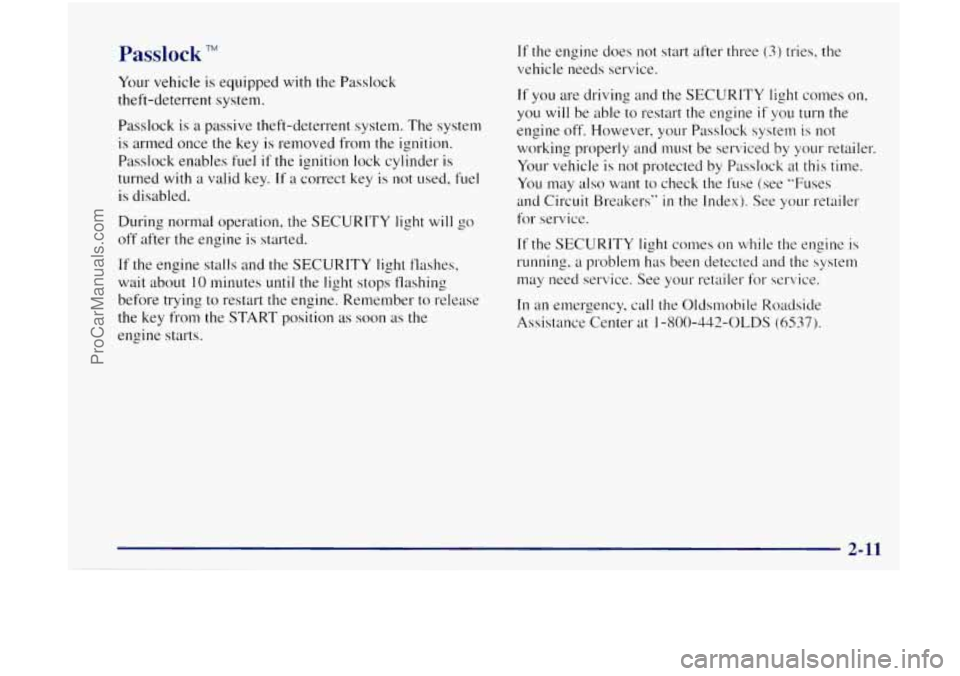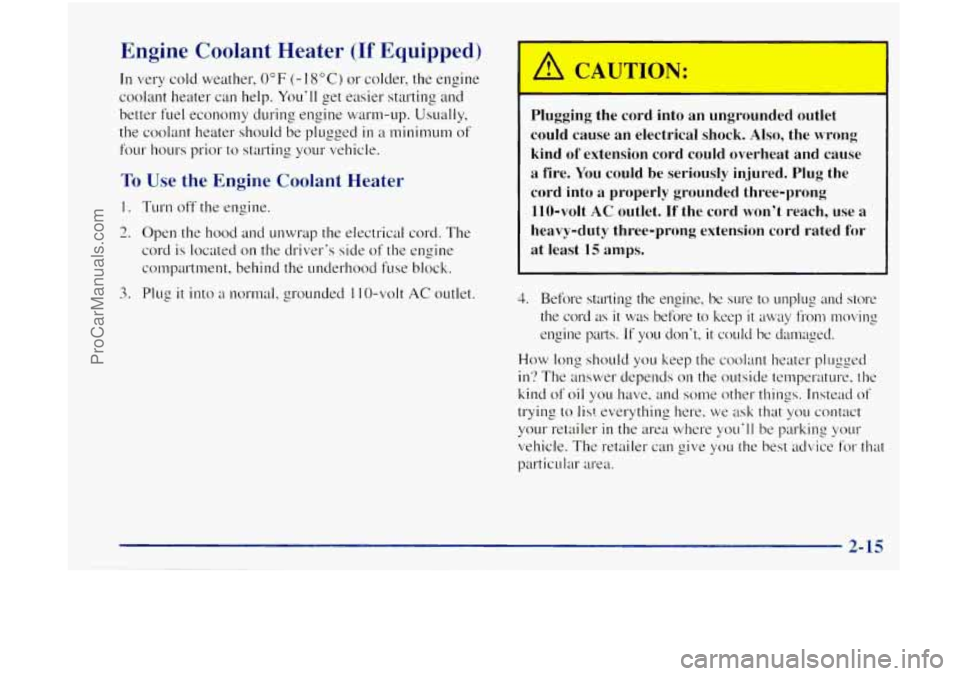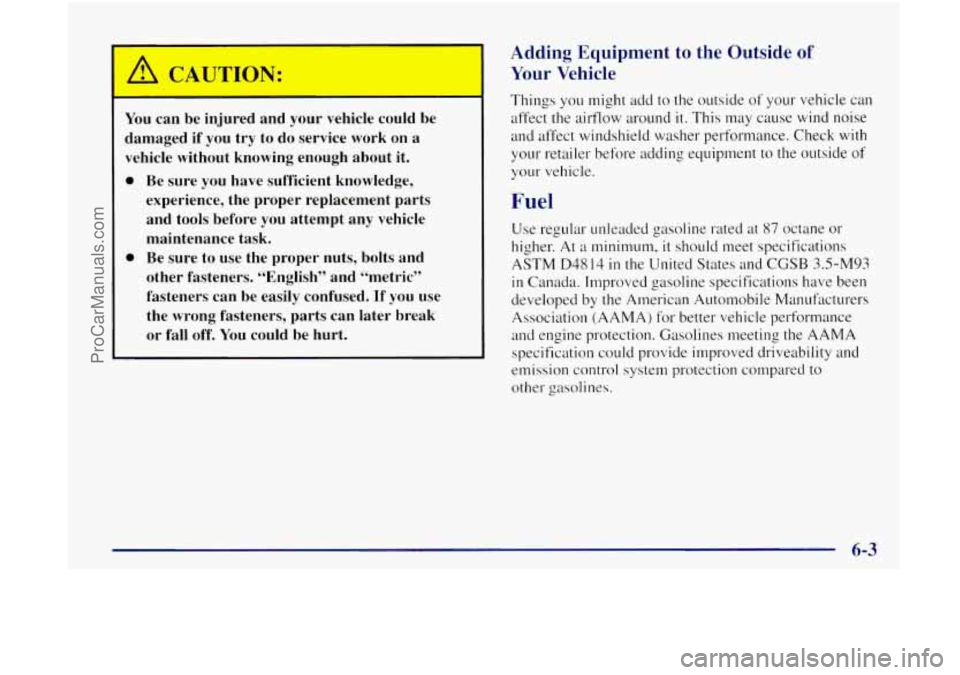fuse OLDSMOBILE BRAVADA 1998 Owners Manual
[x] Cancel search | Manufacturer: OLDSMOBILE, Model Year: 1998, Model line: BRAVADA, Model: OLDSMOBILE BRAVADA 1998Pages: 380, PDF Size: 19.2 MB
Page 11 of 380

Vehicle Symbols
These are some of the symbols you may find on your vehicle.
For example,
these symbols
are used on
an
original battery:
POSSIBLE A
CAUTION
INJURY
PROTECT EYES BY
SHIELDING
CAUSTIC
ACID COULD
x
BATTERY
CAUSE
BURNS
AVOID
SPARKS
OR
FLAMES
SPARK
OR ,\I/,
COULD
FLAME
EXPLODE BATTERY
These symbols
are important
your passengers
whenever your
vehicle
is
driven:
for
you and
FASTEN
SEAT
BELTS
These symbols
have
to do with
your lamps:
SIGNALS 9
TURN
RUNNING
' 0
DAYTIME .
LAMPS **
FOG LAMPS $0
These symbols
are on some
of
your controls:
WINDSHIELD
WIPER
CS 0b
WINDSHIELD DEFROSTER
WINDOW
DEFOGGER
VEN TlLATlNG
FAN
These symbols are
used on
warning and
indicator lights:
COOLANT -
TEMP -
CHARGING BAllERY
SYSTEM
BRAKE
(0)
COOLANT a
ENGINE OIL w,
PRESSURE
Here are some
other symbols
you may see:
FUSE
LIGHTER
n
HORN )tr
SPEAKER
b
FUEL p3
ANTI-LOCK (@)
BRAKES
V
ProCarManuals.com
Page 75 of 380

Passlock TM
Your vehicle is equipped with the Passlock
theft-deterrent system.
Passlock
is a passive theft-deterrent system. The system
is armed once the
key is removed from the ignition.
Passlock enables fuel if the ignition lock cylinder
is
turned with a valid key. If a correct key is not used, fuel
is disabled.
During normal operation, the SECURITY light will go
off after the engine is started.
If the engine stalls and the SECURITY light flashes,
wait about
10 minutes until the light stops flashing
before trying to restart the engine. Remember to release
the key from the START position
as soon as the
engine starts.
If the engine does not start after three (3) tries, the
vehicle needs service.
If you are driving and the SECURITY light comes on,
you will be able to restart the engine if you turn the
engine off. However, your Passlock system is not
working properly and must be serviced by your retailer.
Your vehicle is not protected by Passlock at this time.
You may
also want to check the fuse (see “Fuses
and Circuit Breakers” in the Index). See your retailer
for service.
If the SECURITY light comes on while the engine is
running, a problem has been detected and the system
may need service. See your retailer for service.
In an emergency, call the Oldsmobile Roadside
Assistance Center at
1 -800-442-OLDS (6537).
ProCarManuals.com
Page 79 of 380

Engine Coolant Heater (If Equipped)
In very cold weather, 0°F (-18°C) or colder, the engine
coolant heater can help.
You’ll get easier starting and
better fuel economy during engine warm-up. Usually,
the coolant heater should be plugged
in a minimum of
four hours prior to starting your vehicle.
To Use the Engine Coolant Heater
1. Turn off the engine.
2. Open the hood and unwrap the electrical cord. The
cord is located
on the driver’s side of the engine
compartment, behind the underhood fuse block.
3. Plug it into a normal, grounded 1 10-volt AC outlet.
Plugging the cord into an ungrounded outlet
could cause an electrical shock.
Also, the wrong
kind
of extension cord could overheat and cause
a fire. You could be seriously injured. Plug the
cord into
a properly grounded three-prong
110-volt
AC outlet. If the cord won’t reach, use a
heavy-duty three-prong extension cord rated
for
at least 15 amps.
4. Before starting the engine, be sure to unplug and store
the cord as it was before to keep it away from moving
engine parts.
If you don’t, it could be damaged.
How
long should you keep the coolant heater plugged
in?
The answer depends on the outside temperature, the
kind
of oil you have, and some other things. Instead of
trying to list everything here. we ask that you contact
your retailer
in the area where you’ll be parking your
vehicle. The retailer can give
yo11 the best advice for that
particular area.
ProCarManuals.com
Page 91 of 380

Turn and Lane Change Signals
The turn signal has two upward (for right) and two
downward (for left) positions. These positions allow
you to signal
a turn or a lane change.
To signal
a turn, move the lever all the way up or down.
When
the turn is finished. the lever will return automatically.
An arrow on the
instrument panel
will
flash in the direction of
the
turn or lane change.
To signal a lane change, just raise or lower the lever
until the arrow starts to flash. Hold it there until you
complete your lane change. The lever will return by
itself when you release
it.
As you signal a turn or a lane change, if the arrows don't
flash but just stay on,
a signal bulb may be burned out
and other drivers won't see your
turn signal.
If a bulb is burned out, replace it to help avoid an
accident.
If the arrows don't go on at all when you
signal
a turn, check the fuse (see "Fuses and Circuit
Breakers''
in the Index) and for burned-out bulbs.
If you have a trailer towing option with added wiring for
the trailer lamps,
a different turn signal flasher is used.
With this flasher installed, the signal indicator
will flash
even
if a turn signal bulb is burned out. Check the front
and rear
turn signal lamps regularly to make sure they
are working.
Turn Signal On Chime
If your turn signal is left on for nwre than 3/4 of a mile
( I .2 km), a chime will sound at each flash of the turn
signal. To
turn off the chime., move the turn signal lever
to the
off position.
Headlamp High/Low Beam Changer
To change the headlamps from low to high beam or high
to low beam.
pull the multifunction lever a11 the way
toward you. Then release
it.
When the high beams are
on, this indicator light
on
the instrument panel will
also be on.
ProCarManuals.com
Page 109 of 380

Accessory Power Outlets
With the accessory power outlets, you can plug in
auxiliary electrical equipment. The accessory power
outlets
are located near the center of the vehicle on the
lower part of the instrument panel. Just remove the plug
from the outlet and follow the proper installation
instructions that are included with any electrical
equipment you install.
These circuits are protected by a fuse and have
maximum current levels.
NOTICE:
When using the accessory power outlets,
maximum electrical load must not exceed
25
amps. Always turn off any electrical equipment
when not in use. Leaving electrical equipment on
for extended periods
will drain your battery.
Sunroof (If Equipped)
Your vehicle may be equipped with a power sliding sunroof.
To open or close your sunroof, the ignition or RAP needs to
be
on. See “Retained Accessory Power’‘ in the Index.
Press and release the rear side
of the button in the mini
console to open the sunroof. You can press the forward
side
of the button to close the sunroof. Once the sunroof
is closed, press the forward side of the button to open
the sunroof to the vent position.
The sunroof is also equipped with
a sunshade which you
can
pull forward to block sun rays.
2-45
ProCarManuals.com
Page 169 of 380

Environmental Concerns
Off-road driving can provide wholesome and satisfying
recreation. However,
it also raises environmental
concerns.
GM recognizes these concerns and urges
every off-roader to follow these basic rules for
protecting the environment:
0
0
0
0
0
Always use established trails, roads and areas that
have been specially set aside for public off-road
recreational driving; obey all posted regulations.
Avoid any driving practice that could damage
the
environment -- shrubs, flowers, trees, grasses -- or
disturb wildlife (this includes wheel-spinning,
breaking down trees or unnecessary driving through
streams or
over soft ground).
Always carry a litter bag
. . . make sure all refuse is
removed
f~'om any campsite before leaving.
Take extreme care
with open fires (where permitted),
camp stoves and lanterns.
Never park your vehicle over dry grass or other
combustible materials that could catch fire from the
heat of the vehicle's exhaust system.
Traveling to Remote Areas
It makes sense to plan your trip, especially when going
to
a remote area. Know the terrain and plan your route.
You are much less likely to get bad surprises. Get
accurate maps of trails and terrain.
Try to learn of any
blocked or closed roads.
It's also
a good idea to travel with at least one other
vehicle.
If something happens to one of them, the other
can help quickly.
Getting Familiar with Off-Road Driving
It's a good idea to practice in an area that's safe and
close to home before you go into the wilderness.
Off-road driving does require some new and different
driving skills. Here's what we mean.
Tune your senses to different kinds
of signals. Your
eyes, for example, need to constantly sweep
the terrain
for unexpected obstacles. Your ears need to listen for
unusual tire or engine sounds. With
your arms, hands,
feet and body, you'll need to respond to vibrations and
vehicle bounce.
4-17
ProCarManuals.com
Page 205 of 380

Trailer Wiring Harness
The trailer wiring harness is an eight-wire harness
assembly. The harness
is stored under the vehicle, on the
driver's side corner frame crossmember. The harness has
a 30-amp feed wire
with an inline fuse located by the
junction block. See "Fuses and Circuit Breakers"
in the
Index. The harness does not have
a connector and
should be wired by
a qualified electrical technician. The
technician can use the following color code chart when
connecting
the wiring harness to your trailer.
Dark Blue: Use for electric trailer brakes or
auxiliary wiring.
Red: Use for battery charging; it connects to the
starter solenoid.
Light Green: Back-up lamps.
Brown: Tdillarnps and parking lamps.
Yellow: Left stoplamp and turn signal.
Dark Green: Right stoplamp and turn signal.
White (Heavy Gauge): Ground wire.
White (Light Gauge): Auxiliary stoplamp.
Securely attach the harness to the trailer, then tape
or strap it to your vehicle's frame rail. Be sure you leave
it loose enough so the wiring doesn't bend or break, but
not
so loose that it drags on the ground. Store the
harness
in its original place. Wrap the harness together
and tie
it neatly so it won't be damaged.
ProCarManuals.com
Page 245 of 380

You can be injured and your vehicle could be
damaged
if you try to do service work on a
vehicle without knowing enough about it.
0 Be sure you have sufficient knowledge,
experience, the proper replacement parts
and tools before you attempt any vehicle
maintenance task.
0 Be sure to use the proper nuts, bolts and
other fasteners. “English” and “metric”
fasteners can be easily confused.
If you use
the wrong fasteners, parts can later break
or fall off. You could be hurt.
Adding Equipment to the Outside of
Your Vehicle
Things you might add to the outside of your vehicle can
affect the airflow around
it. This may cause wind noise
and affect windshield washer performance. Check with
your retailer before adding equipment to the outside
of
your vehicle.
Fuel
Use regular unleaded gasoline rated at 87 octane or
higher.
At a minimum, it should meet specifications
ASTM
D48 14 in the United States and CGSB 3.5-M93
in Canada. Improved gasoline specifications have been
developed by the American Automobile Manufacturers
Association (AAMA) for better vehicle performance
and engine protection. Gasolines meeting the AAMA
specification could provide improved driveability and
emission control system protection compared to
other gasolines.
ProCarManuals.com
Page 252 of 380

When you lift the hood, you’ll see these items:
A. Battery
B. Coolant Recovery Tdnk
C. Engine Oil Dipstick
D. Engine Oil Fill
E. Transmission Dipstick
F. Power Steering Reservoir
G. Brake Master Cylinder
H. Air Cleaner
I. Engine Compartment
J. Windshield Washer Fluid
Fuse Block
6-10
ProCarManuals.com
Page 296 of 380

Electrical System
Add-on Electrical Equipment
I NOTICE:
~ ~~~~~~
Don’t add anything electrical to your vehicle
unless you check with your retailer first. Some
electrical equipment can damage your vehicle
and the damage wouldn’t be covered by your
warranty. Some add-on electrical equipment can
keep other components from working as
they should.
Your vehicle has an air bag system. Before attempting to
add anything electrical to your vehicle. see “Servicing
Your Air Bag-Equipped Vehicle”
in the Index.
Headlamps
The headlamp wiring is protected by an internal circuit
breaker.
An electrical overload will cause the lamps to
go on and off. or in some cases to remain off. If this
happens, have your headlamp wiring checked
right away.
Windshield Wipers
The windshield wiper motor is protected by a circuit
breaker
and a fuse. If the motor overheats due to heavy
snow, etc.,
the wiper will stop until the motor cools. If
the overload is caused by some electrical problem, be
sure to get
it fixed.
Power Windows and Other Power Options
Circuit breakers protect the power windows and other
power accessories. When
the current load is too heavy,
the circuit breaker opens
and closes, protecting the
circuit
mtil the problem is fixed or goes away.
6-54
ProCarManuals.com